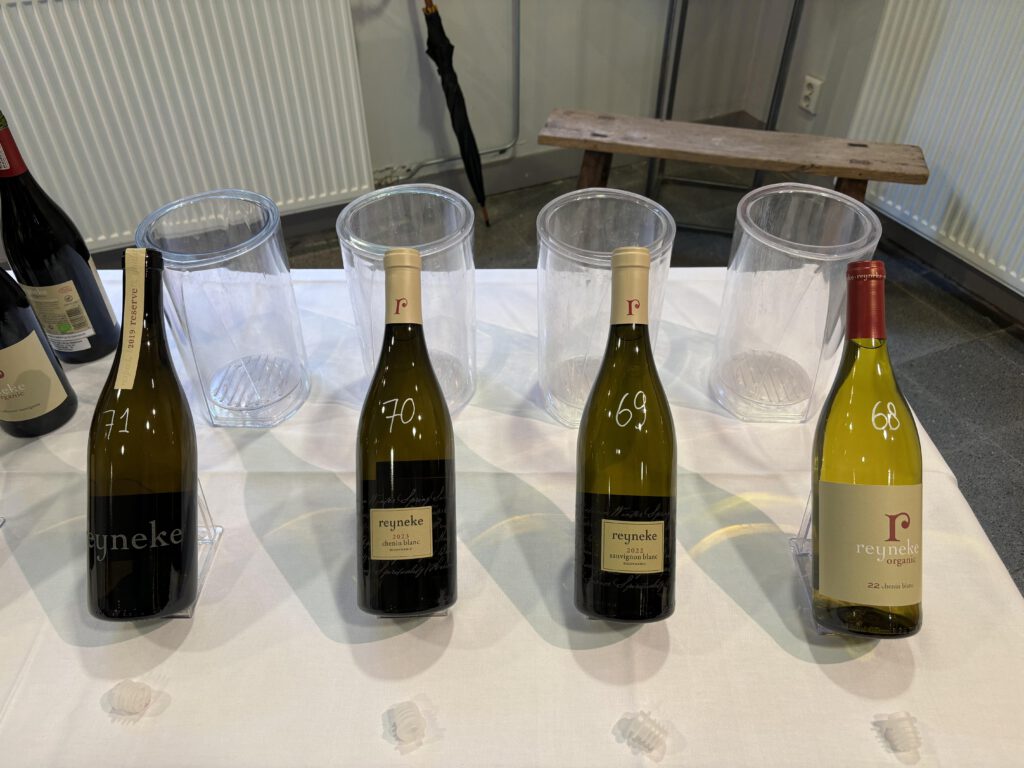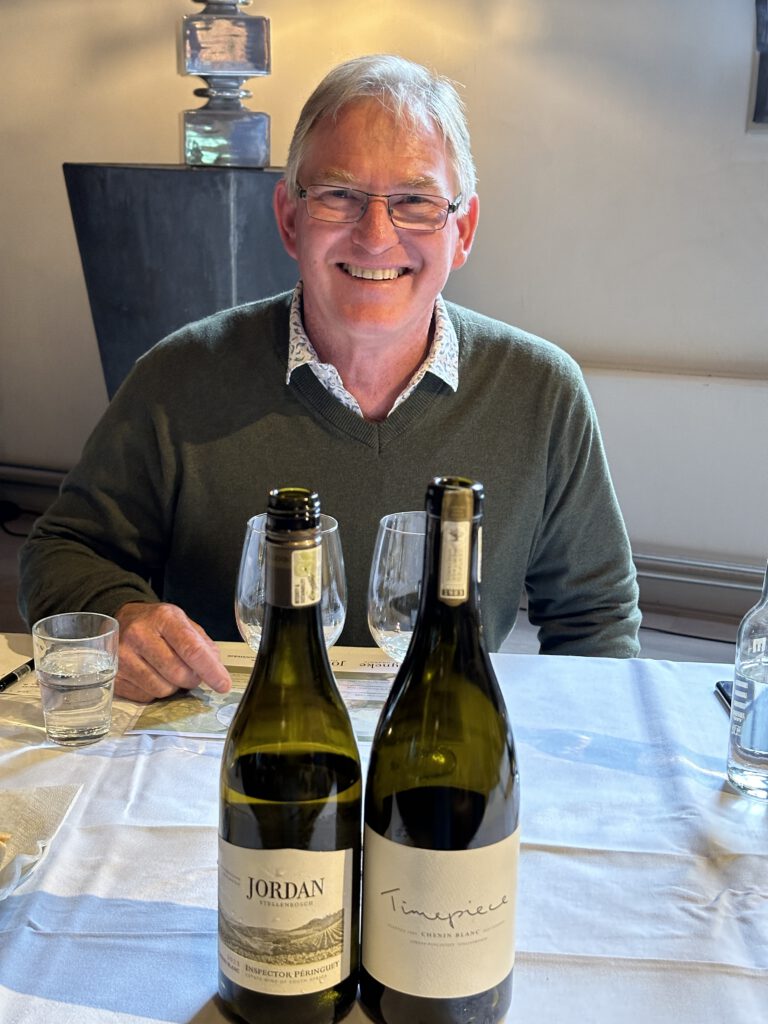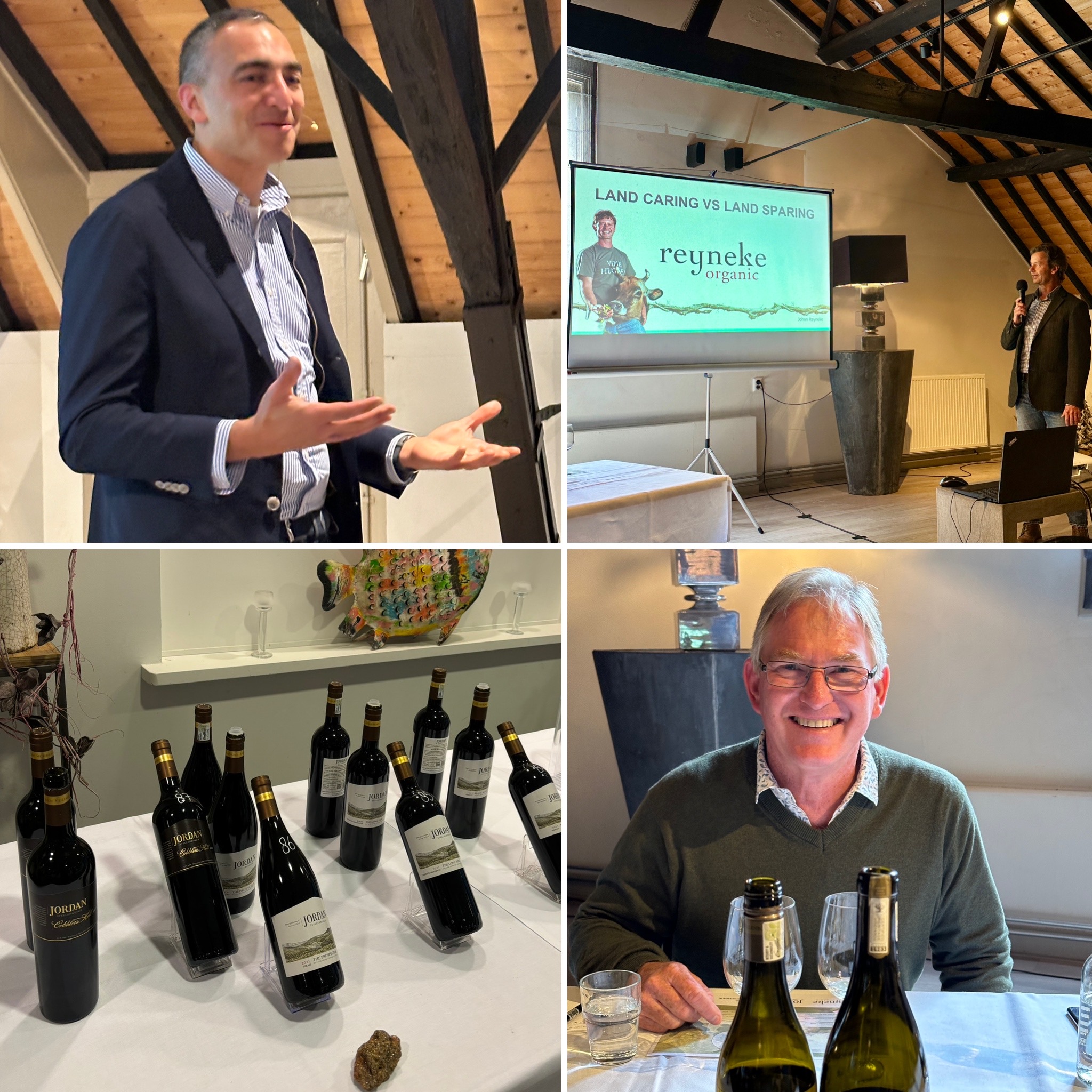Pallas Wines Terroir Day 2024: Barolo and Chenin Blanc.
Pallas Wines is renowned for importing wines from quality, terroir-driven producers. Pallas each year organizes a Terroir Day to spotlight specific regions or grape varieties (last year’s report on Sangiovese can be found here).
This year, the focus was on Barolo and Chenin Blanc. We attended two well-documented masterclasses, which included enough technical knowledge and tastings, presented by Joep Speet, Pallas’s head buyer, and a Magister Vini, the highest Dutch diploma in the field of wine.
First masterclass: G.D. Vajra, Born from the Passion of Aldo Vaira
In the first masterclass, Giuseppe Vaira guided us through the history, grape growing, and winemaking, of G.D. Vajra, followed by a tasting (to read more about G.D. Vajra you can read an earlier deep-dive by our Hermen here).
Barolo, often called “the wine of kings, the king of wine,” has a long and storied history. Among the renowned producers in this region, Vajra is a relatively new face with modern ideas, yet it profoundly understands and incorporates the rich traditions of Barolo.
Vajra was founded in 1968. The first generation, Aldo Vaira, was born into a family in Turin but was sent by his father to his grandparents’ farm in Barolo for the summer to distance him from the protests that were happening in Turin. With his grandparents’ guidance, Aldo spent his time working with vines there, inspiring him to stay in Barolo. In 1972, he bottled his first wine under the family name, marking the beginning of Vajra.
In Barolo commune, the further south you go, the cooler the winds from Alta Langa. G.D. Vajra is based in Vergne, the highest hamlet in the commune of Barolo, which is a key characteristic.

Vajra’s Philosophy: Respect to Nature and Tradition
Here, Aldo started organic farming, thanks to an encounter with a faculty member in his university days, Francesco Galofalo. Talking about organic farming in the 1970s wasn’t a mainstream idea. We can see Aldo’s progressive and thoughtful mind.
Vajra also embraces massal selection. When growers want to plant new vineyards or replace older vines, they typically buy vines from nurseries that source cuttings from ‘mother gardens’ planted with certified clones (clonal planting). However, some growers prefer to use cuttings from old vineyards planted before the days of clonal planting. These older vineyards often contain vines propagated from successful regional vineyards’ cuttings, leading to clonal variation (massal selection).
“When you walk into a non-clonal vineyard, you realize every vine is different. When you’re pruning or training them, there’s diversity to manage. However, my dad always had this vision that there was beauty in diversity, allowing for better resilience of the vineyards,” Giuseppe pointed out.
Diversity demands meticulous care from growers. For instance, Vajra employs a three-step sorting process, including hand-picking with small baskets, because they don’t want to mix old vines and young ones replanted in an old block.
Notable aspects of winemaking include using the submerged cap method, an ancient technique to extend maceration after fermentation. A frame keeps the cap under the level of the liquid. This method protects the cap from molds, while allowing for gentle extraction. The submerged cap can result to a maceration time of almost 60 days, resulting in more nuanced yet greater flavor compounds, increased color stability, and softer tannins.
A Journey from Old to New
Some of the highlights from the Vajra tasting included ancient varieties and unique examples from the perspective of Italian wine, making for an exciting experience.

Vajra 2023 Riesling Pétracine | Langhe DOC | 100% Riesling
Oldest Riesling vines in Piemonte, planted in 1982. The varied soil compositions in some parcels contribute to its high tension. Fresh and pure, with yellow apple, yellow peach, mango, lemon, grapefruit, lemon peel, elderflower, and a hint of ginger. Bright and harmonious with a balanced weight and refreshing high acidity. A persistent finish with notable minerality and a sapid mouthfeel. DWA score: 91-Points (KU)
Vajra 2022 Langhe Freisa Kyé | Langhe DOC | 100% Freisa
Closely related to Nebbiolo, with a noble structure yet fruitier and plumper. Crunchy red plum, blackberry, black cherry, savory spices, mint, and smoke. Full-body with refreshing high acidity, slightly rustic tannins, and a long finish. Its structure and fruit richness contribute to its age-ability. DWA score: 90-Points (KU)
Vajra 2022 Viola delle Viole Barbera d’Alba Superiore | 100% Barbera
Grown on steep, limestone-rich slopes, producing a very small crop with small berries and thick skins. Gentler tannins from fruits than oak ones (oak is used minimally).
Expressive fruity, ripe red berries, blueberry, violet, mint, and sweet spices. Rounded and harmonious palate, featuring textural richness from soft, ripe tannins and fresh acidity, with a hint of balsamic note. DWA score: 92-Points (KU)
Giuseppe led us through a Barolo 2020 tasting featuring two flights: one from the west and the other from the east. The 2020 vintage was notable for its long growing season and beautiful flowering, which promised fruitiness. It also allowed for extended skin contact, resulting in a fruitier and more open style.
Vajra 2020 Barolo Coste Di Rose | 100% Nebbiolo
Coste Di Rose MGA is on a steep slope with pure sandstone soils.
Elegant, charming, and refined profile, with red currant, red cherry, ripe strawberry, rose petals, mint, and sweet spices on the nose. High yet silky tannins are approachable and juicy. A persistent long finish with a mineral note. DWA score: 93-Points (KU).
Vajra 2020 Barolo Ravera | 100% Nebbiolo
Recognized as Novello’s foremost single vineyard on a steep slope (320-240m). Giuseppe described this wine as AC/DC or Led Zeppelin compared to the summer beach song for Coste di Rose.
Layered aromas of wild strawberry, blood orange, dried flowers, mint. Juicy yet structured, concentrated fruit flavors, lingering finish with notable mineral nuances reminiscent of iron. DWA score: 95-Points (KU).
Bricco delle Viole 2020 | 100% Nebbiolo
Highest vineyard in Barolo (400-480m) above the fog line, basking in abundant sunlight and experiencing significant diurnal temperature variations, resulting in a great structure. Unique soil is of Tortonian-era (Sant’Agata marl and fossil).
The nose reveals ripe, opulent fruits of red cherry, berries, and floral hints (rose petal, violet), all beautifully accented by nuances of spice notes (licorice and tar). Remarkable structure, characterized by high silky tannins and high vibrant acidity, yet well-integrated, rounded on the palate. A spicy finish that lingers delightfully. Generous and sophisticated Barolo. DWA score: 95-Points (KU).
Since 2008, Vajra has been the guardian of the Luigi Baudana winery and vineyards.
Luigi Baudana, 2020 Baudana | 100% Nebbiolo
A historical MGA in Serralunga d’Alba, with a southwest orientation and a mix of Tortonian and Helvetian soils, offering a broader profile, along with higher acidity.
Nose is still closed with restrained notes of blue plum, black cherry, dried strawberry, and violet. The palate is highly structured, with intense fruit flavors and balsamic, tar, and leather notes. Ripe tannins and high, vibrant acidity lead to a lingering finish. Significant aging potential. DWA score: 95-Points (KU).
Second Master Class: Chenin Blanc
In the second master class, Joep Speet (representing Château Soucherie), Johan Reyneke (representing Reyneke Wines) and Gary Jordan (representing Jordan Wines) guided us through different expressions of Chenin Blanc, resulting in different styles, originating from different terrors.
Reyneke Wines
Located in Stellenbosch, South Africa, just 14 km from False Bay, the terroir of Reyneke is exceptional. With altitudes ranging from 100 to 300 meters, which is higher than the average area in Stellenbosch, it enjoys a cool temperature thanks to the altitude and ocean breeze year-round, especially from the cold ocean’s close proximity.

Johan began organic farming in 2000 and has since transitioned to biodynamic practices. Additionally, Reyneke maintains a carbon-negative status for now. Johan believes in farming regeneratively, especially in the condition that the effects of global warming become more pronounced. Biodynamic farming increases soil microbe and humus levels, enhancing natural resilience and fostering a self-sufficient ecosystem. This approach allows the terroir to express its true sense of place. Thanks to the farm’s biodiversity, you can find a variety of beautiful animals and plants that have been rewilded.
Reyneke collaborates with Rosa Kruger and the Old Vine Project. Old vines, because they have deeper roots and a bigger root system, typically better absorb water and nutrients from the soil. Biodynamic practices work well for old vines, too, such as increasing humus levels and using cover crops to help maintain lower soil temperatures. This results in a Chenin Blanc that retains its tension and has a fresher style.

2023 BIO Reyneke Biodynamic Chenin Blanc
The grapes were sourced from old vines planted in 1974 and 1979, yielding significantly low. They were fermented in 300L oak foudres, and aged in old oak on lees for 10 months. The minimum usage of SO2 kept the fruits pure.
Concentrated fruit aromas of quince, pear, honeysuckle, green apple, melon, Mayer lemon on the nose. Lively high acidity, creaminess on the palate, and persistent long finish with salinity aftertaste. DWA score: 92-Points (KU).
Jordan Wines
As a close neighbour to Reyneke, Jordan Wines is also located in Stellenbosch. Gary’s parents, Ted and Sheelagh, bought the 164-hectare property in 1982 and began replanting it with classic grape varieties suited to the diverse soils and slopes. Gary, a former geologist, studied winemaking at UC Davis before returning home in 1992 to build a cellar with his wife, Kathy, who also studied winemaking in France. Together, they started producing wines under their own label.

Jordan Winery’s terroir is characterized by Cape granite and sandstone from Table Mountain. They cultivate varieties like Chenin Blanc, Cabernet Sauvignon, Assyrtiko, and Riesling, each chosen to best express the unique terroir. Gary and Kathy make their wines using a combination of stainless steel, old oak, amphorae, and concrete eggs.
2022 Jordan Timepiece Chenin Blanc
This collection includes single-vineyard wines from their estate vineyard, which is 40 years old. It is a cool, south-facing vineyard, 195m above sea level. The wines were fermented in old barrels containing 400L terracotta amphora and 600L concrete eggs.
Great concentration and depth, with fresh pineapple, quince, orchard fruits, lemon, grapefruits, honeysuckle, and hay. Smooth texture with creaminess, less bitterness, and weight on the mid-plate. Persistent long finish. DWA score: 94-Points (KU).

Château Soucherie
Nestled between two rivers, the Chateau was built at the end of the 19th, and the Beguinot family took charge of Château Soucherie in 2007. The 28-ha vineyards are located on a shale hillside facing south and sheltered from northern winds, producing wines mainly with Chenin Blanc through Anjou Blanc, Savennières, Coteaux du Layon, and Premier Cru Chaume.
Due to respect for the terroir and the environment, their work on the vines is carried out manually. Also, the harvest is carried out for sweet wine by sorting only 100% botrytis. Chateau Soucherie converted to organic farming and was certified AB in 2022.
2021 Soucherie Savennières Clos Des Perrieres
Lemon, green apple, herbs, melon, vanilla, and clove on the nose. Dry, electrically high acidity and creamy texture are counterbalances of the concentration and depth of flavors. They are still too young to enjoy their full potential but have a long aging potential. DWA score: 93-Points (KU).
2015 Soucherie 1er Cru Chaume
Development with noble rot shows the aromas of dried apricots, marmalade, honey, hay, and white soy sauce, in addition to fresh citrus, green apple, and herbal notes on the nose. Medium-dry sweetness is balanced with high racy acidity and very complex flavors. There is a slight phenolic bitterness aftertaste. DWA score: 94-Points (KU).
Conclusion
Thanks to the excellent work of Pallas Wines, we gained a comprehensive understanding of the various perspectives on “terroir” in each wine. This encompasses not only the natural environment and vineyard establishment—such as climate, soil, orientation, and microclimate—but also the impact of organic and biodynamic farming, which, for instance, alters soil conditions. Additionally, the careful selection of plant material to suit the terroir plays a crucial role. All these factors contribute to the style and quality of each wine, and the two masterclasses explained this beautifully.
This article is written by our own Kazumi Uejo. We thank Pallas Wines and especially Joep Speet for organizing and inviting us to this Terroir Day. We also thank Giuseppe Vaira, Johan Reyneke, and Gary Jordan for sharing their knowledge and philosophy.
The producers and wines mentioned in this article are available through selected retail and hospitality partners of Pallas Wines in the Netherlands.

